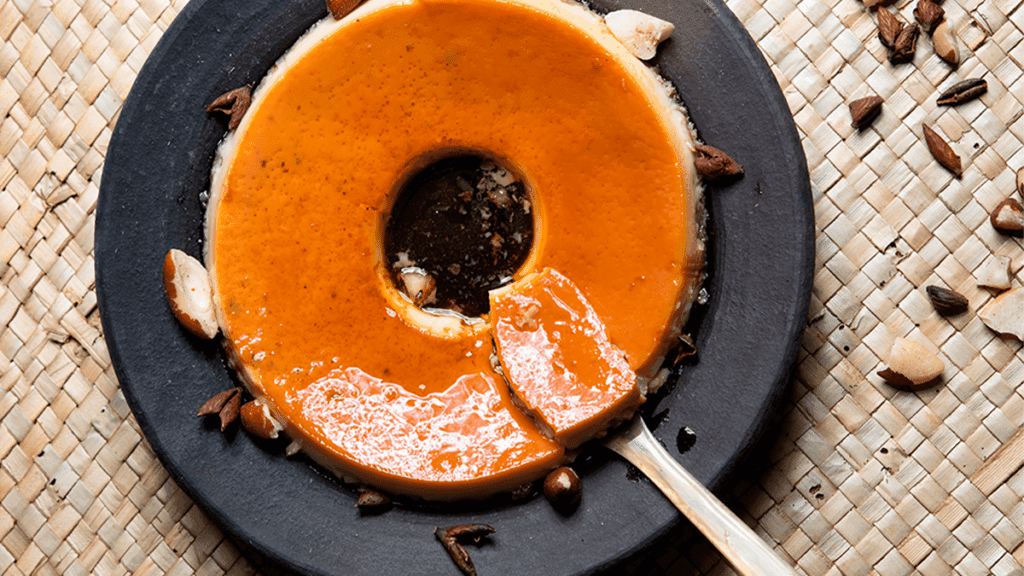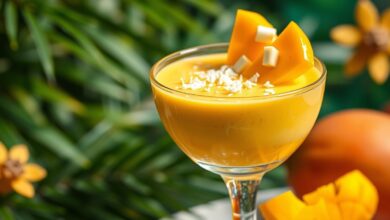Old-Fashioned Milk Pudding: A Classic and Unforgettable Recipe
O traditional milk pudding, also known as traditional milk flan, evokes affectionate memories and the comforting taste of homemade cooking. Unlike the popular condensed milk pudding, this classic version, rich in history and flavor, uses simple ingredients like milk, eggs, sugar, and vanilla, resulting in an elegant and incredibly delicious dessert. In this recipe, we will explore the step-by-step process to prepare an authentic traditional milk pudding, with tips and secrets to ensure the perfect texture and flavor that harkens back to childhood and special family moments.

The History and Tradition of Classic Milk Pudding
The origin of milk pudding dates back to French crème caramel a classic dessert that crossed borders and adapted to different culinary cultures. In Spain, it is known as flan, while in Portugal it takes on various names such as pudim de leite, pudim flan, pudim marfim, and pudim de ovos. All these variations share the base of eggs, milk, and caramelized sugar, with subtle differences in flavoring, which can range from classic vanilla to lemon zest or cinnamon.
The traditional milk pudding stands out for its simplicity and delicate taste that comes from the harmonious combination of fresh, quality ingredients. The absence of condensed milk highlights the pure flavor of the milk, eggs, and the subtle touch of vanilla, creating a unique taste experience that pleases palates of all ages.
Essential Ingredients for a Perfect Milk Pudding
To prepare an authentic and flavorful traditional milk pudding, the choice of ingredients is fundamental. Opt for:
- Fresh Whole Milk: Whole milk gives creaminess and body to the pudding. The quality of the milk directly impacts the final result.
- Farm Eggs: Fresh eggs, preferably free-range, provide a richer flavor and vibrant color to the pudding. Straining the eggs is a secret to avoid a strong taste and to ensure a smoother texture.
- Refined Sugar: Refined sugar is ideal for the caramel and to sweeten the pudding, providing the perfect balance of sweetness.
- Quality Vanilla: Vanilla is the aromatic soul of traditional milk pudding. Use pure vanilla extract, vanilla bean, or homemade natural essence for an authentic and unmatched flavor.
Detailed Step-by-Step Recipe for Traditional Milk Pudding
Now, let’s prepare the classic traditional milk pudding recipe. Follow this detailed guide to achieve a perfect result:
Golden Caramel: The Initial Secret
- In the pudding mold (preferably with a central hole), add 1 cup of refined sugar.
- Place the mold directly over low heat, stirring gently with a spoon or heat-resistant spatula until the sugar completely melts and acquires a golden amber color. Avoid burning the caramel as it can become bitter.
- Carefully tilt the mold and rotate it so the caramel evenly coats the bottom and sides. Set aside.
Preparation of the Pudding’s Delicate Custard
- In a large bowl, mix the remaining sugar (2 cups) with the whole milk and vanilla. Stir gently until the sugar dissolves.
- In another bowl, break the eggs and strain them through a fine sieve. This step is crucial to remove the egg membrane, which can give an undesirable taste.
- Add the strained eggs to the milk and sugar mixture, and stir gently with a wire whisk or fork just to incorporate the ingredients. Avoid vigorous beating to prevent excess air, which can cause bubbles in the pudding.
Cooking in a Bain-Marie: Patience and Care
- Pour the pudding custard gently into the caramel-coated mold.
- Prepare the bain-marie: In a baking tray, place a kitchen towel at the bottom (to prevent the mold from slipping and to distribute heat evenly). Place the pudding mold on the towel.
- Add boiling water to the baking tray, reaching approximately halfway up the height of the pudding mold.
- Place in a preheated oven at 160°C (medium-low oven) for about 1 hour and 30 minutes to 2 hours, or until the pudding is firm. To check doneness, insert a toothpick in the center of the pudding; it should come out clean.
- Remove the pudding from the oven and let it cool completely at room temperature. Then refrigerate for at least 6 hours, ideally overnight.
Unmolding and Serving: The Grand Finale
- To unmold, run a thin, non-serrated knife along the edges of the pudding to loosen it from the mold.
- Quickly dip the base of the mold in warm water for a few seconds (this trick helps loosen the caramel).
- Place the serving plate over the mold, quickly and gently flip it. If the pudding doesn’t come out immediately, gently tap the bottom of the mold.
- Serve the traditional milk pudding chilled, with the delicious caramel sauce that formed in the mold.
Tips and Tricks for a Perfect Traditional Milk Pudding
To improve your recipe and ensure a flawless traditional milk pudding, consider these valuable tips:
- Smooth or Textured? Pudding texture preference varies. For a smooth pudding, mix ingredients gently and bake at a low temperature. For a pudding with small holes, mix a bit more vigorously (without overdoing) and bake at a medium temperature.
- Oven Temperature Control: The ideal temperature for the bain-marie in the oven is between 160°C and 180°C. Higher temperatures can cook the pudding too quickly and dry it out.
- Stovetop Bain-Marie: If preferred, the pudding can be cooked on the stovetop using a bain-marie. Use a large pot with boiling water and cook on low heat, covered, for about 45-60 minutes.
- Pressure Cooker Pudding: A quicker option is to cook the pudding in a pressure cooker. Cover the mold with aluminum foil and tie it securely. Place it in the cooker with water up to half the height of the mold and cook for 10-15 minutes after pressure is reached. Release pressure naturally.
- Aromatic Variations: Try adding lemon zest, orange zest, or cinnamon sticks to the milk for a distinctive aromatic touch. Vanilla bean also elevates the flavor to another level.
- Patience in Cooling: Respecting the cooling and refrigeration time is crucial for the ideal texture and flavor of the pudding.
Storage and Enjoyment of Classic Milk Pudding
Traditional milk pudding can be stored in the refrigerator for up to 5 days, maintaining its texture and flavor. It is perfect to prepare ahead to welcome friends and family or to enjoy a special dessert throughout the week.
Serve the pudding chilled, plain or accompanied by fresh fruits such as strawberries or raspberries for a refreshing contrast. A scoop of cream or coconut ice cream also pairs perfectly with the sweetness of traditional milk pudding.
Conclusion: Rescuing Flavors and Memories with Traditional Milk Pudding
Making a traditional milk pudding is more than cooking a dessert; it’s rescuing a piece of culinary history, a flavor that crosses generations and connects us to happy moments. The simplicity of the ingredients and the elegance of the result make this recipe a timeless classic, perfect to celebrate special occasions or simply sweeten everyday life with a touch of nostalgia and affection. Try this recipe, share it with your loved ones, and enjoy the magic of traditional milk pudding!
Image Source: tanamesa







